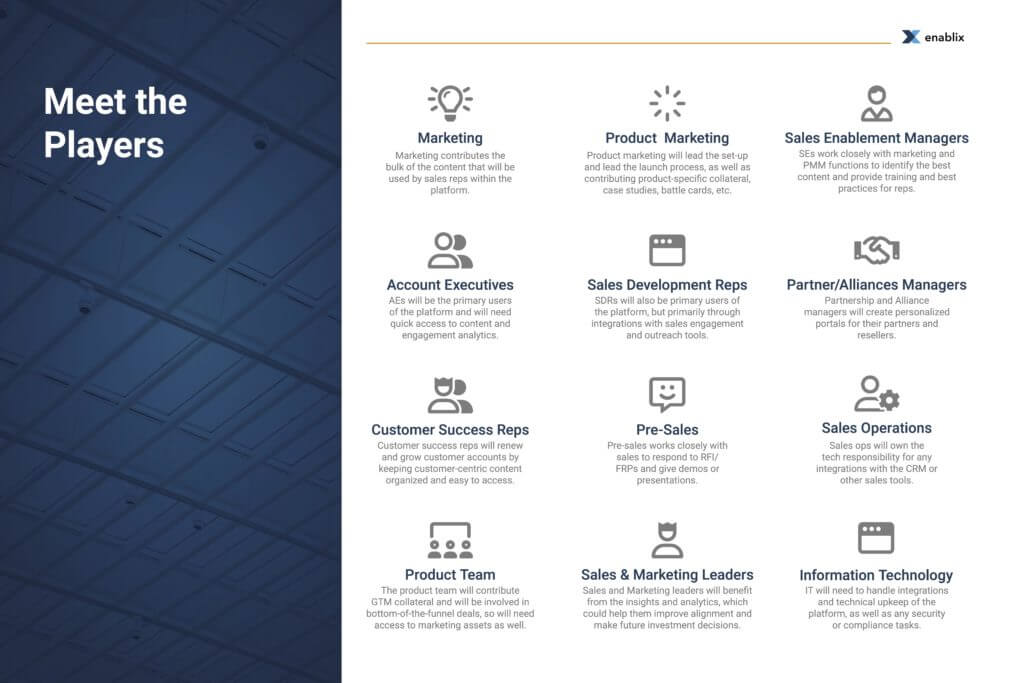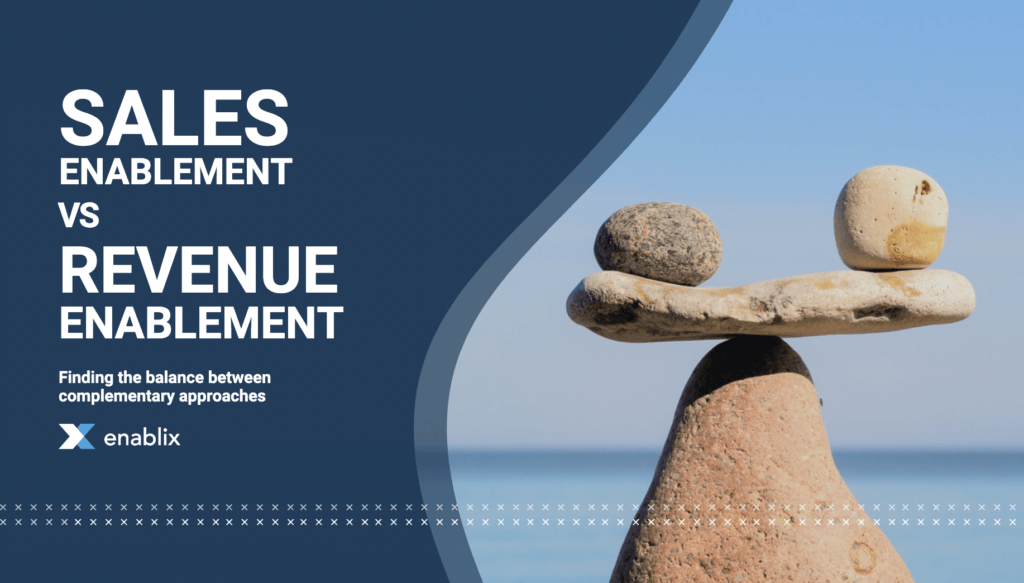Recently, many in the industry have taken to calling many standard sales enablement approaches by a new name: revenue enablement. In fact, many are seeing revenue enablement as a cure-all that will help with stale enablement patterns that haven’t been working: Gartner has gone as far as to say that revenue enablement is “the solution to keeping up with changing buying habits”.
But revenue enablement and sales enablement are not the same thing. In this article, we break down what each term represents and how they’re distinct from each other to help you decide which approach will best work for you.
Read the article below, or click here to download the full guide!
tl;dr
While Sales Enablement puts a focus on enabling the sales team to generate net new revenue, Revenue Enablement takes a broader approach and aims to enable all revenue-facing teams to not only acquire new revenue but increase existing revenue as well.
Table of Contents
What is Sales Enablement?
If you’re here, you likely have an idea for what sales enablement is. At its core, sales enablement is ensuring that the sales team has the tools to be successful. Check out how some of our friends across the industry define it:
Sales enablement is the iterative process of providing your business’s sales team with the resources they need to close more deals. These resources may include content, tools, knowledge, and information to effectively sell your product or service to customers.
Sales enablement is the process of providing the sales organization with the information, content and tools that help salespeople sell more effectively.
Sales enablement uses content, coaching, training, and technology to help reps onboard, improve their skills, and sell. Sales enablement leaders care about increasing productivity, making a business impact they can measure, and getting training programs out the door faster.
The important thing to note here is that every definition focuses on the sales team getting new revenue and logos. Whether through training, tooling, or sales and marketing alignment, the whole objective is arming sales with what they need to sell more.
What is Revenue Enablement?
Revenue enablement takes the same objectives of sales enablement, but zooms out to apply them to all revenue-facing teams.
Rather than focusing solely on sales and marketing, revenue enablement strives to get all of the revenue-facing teams (Sales, Marketing, PMM, SE, Customer Success, Partnerships, Pre-Sales, etc.) working together towards the unified goal of raising revenue.
To Gartner’s point above, Revenue Enablement sprung out of a need to tear down silos that were forming between certain parts of the rev organization. Focusing too myopically on enabling the sales team has the potential to sideline the customer success or partnership teams, for example, which forces them to get their own tools, create their own training, and act independently of the sales org.
In our recent Revenue Enablement Platform Implementation Guide we broke down the 12 teams that can potentially be involved in a revenue enablement program:

Sales Enablement vs Revenue Enablement
Oftentimes, the difference between the two methods simply boils down to scaling best practices across different teams. To best detail how sales enablement is different from revenue enablement, let’s break down a few common use cases:
Enablement Use Case #1: Understanding Prospect Engagement
Sales Enablement Approach: Sales reps have the ability to send content and track prospect engagement with anything they send; They can map this engagement through the buyer’s journey and use it to influence any other content that the rep sends.
Revenue Enablement Approach: A single content library is set up that supports all revenue-facing teams in ways that are specific to their job function. While Sales teams have the ability to share content and receive analytics on how different members of each account engage with relevant material, the marketing team can share content in social updates or in email through tools like Pardot or Hubspot.
These unified analytics better track the different touchpoints a prospect or target account will have with your brand, and can be exported to the organization’s CRM. From there, revenue teams can put together the entire buyer’s journey combined between outbound sales, marketing, and inbound sales leading all the way to a deal’s closing.
Enablement Use Case 2: Creating Buyer Experiences
Sales Enablement Approach: Sales teams have the ability to create a dedicated microsite or “deal room” with personalized content for prospects, which can be changed throughout the deal to support the prospect’s latest questions and needs.
Revenue Enablement Approach: Outbound SDR’s can measure which of their top-of-the-funnel prospects are showing content engagement, and can build personalized content experiences for them to nurture them through the sales funnel – things like blog posts, case studies, and fact sheets.
Once the prospect has an introductory call and is passed to the Account Executive, the AE can take over the same microsite and update it with assets that are more relevant to the deal – call recordings, mutual action plans, and testimonials.
After the prospect signs on as a customer, the AE transfers the page to a CSM, which keeps the page active throughout onboarding and into customer care with materials like onboarding plans, checklists, and steps to launch.
In this paradigm, buyer experiences can easily flow through to customer experiences keeping a singular touchpoint for content between the two companies. All engagement with the content is still tracked and analyzed if necessary, and all handoffs are easily understood and seen by everybody.
Enablement Use Case 3: Making Sales Content Readily Available to Channel and Partner Sellers
Sales Enablement Approach: Although the partner team is aligned with the sales team internally, they purchase a separate partner portal software for any partner management or content needs. Partners either log into those portals to find relevant content, or get a newsletter-style update of what’s new from the company.
Revenue Enablement Approach: Partners are granted access to the same enablement assets that internal selling teams have – but with various built-in filters that prevent them from accessing or sharing any information they don’t have permission to see. All partner interaction, from how they log into the platform to the assets they search and share, become data points for the internal partner teams as well as the content marketing teams. These content metrics can become KPI’s for partner enablement managers, or can simply flow down to marketing to influence the kinds of assets that are produced for different kinds of partners.
In addition, communication between internal sales teams and partners remains fluid – partners can leave feedback on content and trainings, and internal teams can view and respond appropriately.
What's Right For You?
To be clear – this isn’t a case of sales enablement versus revenue enablement, with one being better or worse. These are simply different methodologies that have arisen over time to address the needs of growing businesses.
But which one is right for you?
Signs that your organization should invest in sales enablement:
- You’re a smaller organization of <50 total revenue facing members
- Your sales team is complaining that they can’t easily find content, and it’s slowing down their ability to close deals
- You have fairly fast sales cycles (<30 days) and haven’t experienced any friction in aligning sales metrics with the customer success
For many companies, the major hurdle to success is the ability to predictably gain revenue from new customers. These organizations are usually smaller and are trying to nimbly respond to the needs of the sales team by connecting them with the resources or training they need. For these teams, sales enablement is a great first step – and success can be measured through rep confidence, asset utilization, and sales rep time to onboard.
Unfortunately, focusing on the sales team generating new revenue can eventually create “revenue silos”, resulting in each team creating its own set of best practices for groups of people that, in reality, should be aligned.
Signs that your organization should invest in Revenue enablement:
- The hand offs between Sales and Customer Success are rocky, or expectations between the teams on where and how customers will start are being missed
- Your sales team accounts for the majority of outbound interactions with your prospects, but your marketing team is blind to account engagement
- All of your revenue facing teams need access to the same set of documents, training sessions, and branding materials
An easy way to tell which methodology you should focus on is to zero in on the specific problems you are having:
Is sales not able to execute to their potential given the resources they have? Sales enablement.
Are multiple revenue-facing teams facing discord between each other because of a logjam over shared content and processes? Revenue enablement.
Further Reading
We hope this guide was helpful in understanding the different methods of scaling revenue and which is right for you.
- If you’re considering implementing a revenue enablement platform, check out our revenue enablement implementation guide
- Our guide to sales enablement insights can be helpful in understanding what a sales enablement platform can educate you about your team
- Our integrations deep dive goes deep on how these tools should interact with the rest of the tech stack
FAQ
How does Marketing’s role change in a shift from sales to revenue enablement?
The largest change is that the revenue enablement approach will highlight an importance on customer marketing. The idea here is that marketing doesn’t stop once someone is no longer a prospect, you’re continuously marketing to them throughout the buyer and user life cycle.
By having CS use a revenue enablement platform to share training and onboarding materials with new customers or for customers up for renewal and expansion, it puts an emphasis on staying in front of the buyer throughout their experience with the brand, which can help marketing embrace and take responsibility for that amount of revenue that they’re helping grow.
Do you measure revenue enablement differently than sales enablement?
The short answer is, yes.
For more detail, let’s focus on the goals that an organization might set for each initiative. For a sales enablement initiative, a good goal can be as simple as “are you enabling the sales team?”. Deal velocity, win %, and time-to-close a deal should be impacted within 3-6 months of starting the team as well. Internal metrics. Sales confidence, weather measured formally through surveys, or informally through conversations, should be going up. Onboarding time for new reps could potentially be going down – but again, you’re mostly going to be measuring the sales team.
Revenue Enablement is going to force a team to take a broader look at how revenue is being affected. Sure, things like deal velocity should be increasing, but net revenue retention and partner-qualified revenue are going to be equally important to an extent.
These goals may be bigger and hairier – for instance, how do you measure brand advocacy? It may be different for every company but , that’s where, especially during economic downturns, scalability, profitability, and reliability come into play to create a stable business.
Where does content Enablement live?
While we’ve written about content enablement in the past and focused a lot of this article around those use cases, it actually is a part of both sales and revenue enablement
Refresher: content enablement is the practice of making everything you create, both internally and externally, more effective for your teams. Whether it’s suggesting training materials to prepare for a deal or finding the right fact sheet for a feature that the prospect might be interested in, it’s really just enabling the assets you’re already creating to be more used by the team.
Content enablement has a home in both methodologies. For instance, content enablement can play a major role in a sales enablement initiative by ensuring that sales reps are armed with the “right content at the right time” – but it can also do more.
Imagine that a Customer Success Manager puts together a large presentation featuring several new features for a client who is up for renewal in an attempt to upsell them to a larger package. In many organizations, that’s where the content ends – that file is locked away or potentially put on a shared drive for a team to use for another client in the future.
But that same presentation could potentially be useful in the sales cycle as well – introducing similar buyers to that feature package and explaining the benefit to them. Opening up cross-team content collaboration and making assets more usable after they are created is absolutely examples of content + revenue enablement.
What Role Does Enablix play between revenue and sales enablement?
That’s the cool part – a single platform can enable both! Let’s talk about how.
Enablix can primarily serve as a sales enablement app for many teams. Our platform can speed onboarding, reduce how long sales reps search for content, and raise sales performance through better access and understanding of content.
However – we’re also built from the ground up to allow all of your revenue-facing teams to work with each other. We’ve powered a complete partner enablement solution while also helping organizations respond to RFP’s faster. Our content pages make collaboration between sales and CS easier while our analytics suite gives sales and marketing leaders a single view of how prospects are interacting with their brand.
If you’re interested in how a single platform can enable all your revenue-facing teams, let us know!
Download The Full Guide Now





